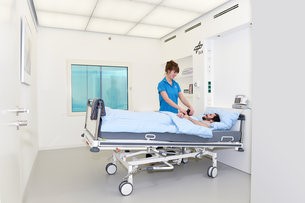极端环境实验
ESA提议在地球进行两个独特实验:隔离和禁闭研究以及人造重力实验。以应对人们在类似于长时间的太空飞行任务时所承受的生理及心理压力。
康科迪亚研究站人因研究——隔离实验
在南极洲的康科迪亚研究站,冬季四个月里,太阳不超越地平线,温度低于-70°C,不会有外界补给或救援。生活在极端的隔绝状态会导致冲突、社会剥夺和绩效下降。隔离实验关注人类从心理、医学和生理角度的适应,有助于选择最佳航天员,并在任务行动中融入人因考虑。
旋转床实验——短臂离心机
在太空中,航天员受到骨质流失、肌肉萎缩和心血管疾病的危害。在长时间的太空任务中,加入人造重力可能是最有效的解决方案。通过设计巧妙的离心机可以人为地制造重力效果,可同时对所有人类器官系统起作用。
实验的两个主要问题是离心机的运转时间和频率。ESA资助卧床实验研究人体如何适应失重状态。实验者卧床数月,由医生定期进行血液采样和测试,记录突然坐起的身体反应。
Run Your Experiments in Extreme Cold Isolation or in Bed
Preparing for space means understanding human adaptation to extremes. How do we cope with life in the coldest, darkest and most remote places on Earth? How can we reduce the harmful effects of space on the human body?
European researchers now have the unique opportunity to propose experiments that tackle the stresses and strains that people endure in conditions similar to long-duration spaceflight missions.
ESA offers to run investigations in two unique areas on Earth to prepare for life in space: isolation and confinement studies, and artificial gravity.
Concordia and the human factor
Isolation challenge
At the Concordia research station in Antarctica, the crew knows that whatever happens, help will never come during the winter months. For four months, the Sun does not rise above the horizon and temperatures fall below –70°C.
Every year, geologists, astronomers and climate scientists conduct research at this base that looks like it came out of science fiction. Living in extreme isolation can lead to conflicts, social deprivation and a decline in performance.
The current Announcement of Opportunity focuses on human adaptation from a psychological, medical and physiological point of view. Its results will contribute to the selection of the best crews and integration of human factors in mission operations.
Spinning in your bed?
Short-arm centrifuge
In space, astronauts suffer from bone loss, muscle weakening and cardiovascular deconditioning. Adding artificial gravity to the equation could turn out to be the most effective solution for a healthier body during long-duration space missions.
There are tools to artificially create the effect of gravity, namely by spinning subjects on cleverly designed centrifuges. Artificial gravity is considered an integrated countermeasure because it addresses all human organ systems at once.
“The advantage of artificial gravity is that it has the promising potential of reducing most of the negative effects of weightlessness on the entire human body in one go,” explains Jennifer Ngo-Anh, leading ESA’s human factors research.

Bedrest study
Two major questions remain open for the scientific community: for how long and how often do you need to keep the centrifuge on. The goal is to find the right combination of artificial gravity, food supplements and exercise.
The most promising ideas will be taken into consideration in the next ESA-sponsored bedrest studies, a way to see how the human body adapts to weightlessness. Participants spend months in bed as doctors take regular blood samples and continuous tests to chart how their body reacts to a sudden sedentary lifestyle.
Scientists are invited to submit their proposals by February 2018. Further information about deadlines, workshops and experiment requirements is available in the dedicated links to the Concordia Announcement of Opportunity and the Bedrest Call for Ideas.


 空间科技快讯
空间科技快讯